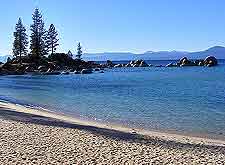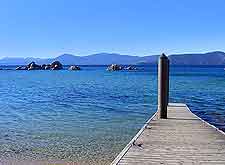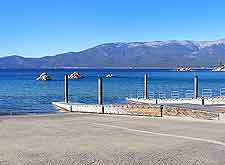Lake Tahoe History Facts and Timeline
(Lake Tahoe, California - CA, USA)

One of America's favorite recreation spots, lovely Lake Tahoe lies in the Sierra Nevada, almost 2,000 meters / 6,560 feet above sea level, being surrounded by Alpine beauty in summer and snow-covered peaks in winter.
In the remote past, the history of the region shows that this was the heartland of the Washoe Native Americans. Nowadays, it's a hub for skiers, snowboarders and other winter sports enthusiasts.
Early Arrivals
The first European to glimpse the lake was Lt. John C. Fremont during his second exploratory trek in 1844. The romantic vistas along the lake's shoreline might have appealed to the explorer, as he first saw them on Valentine's Day. Lake Tahoe's spectacular Meeks Bay saw another early arrival, John Calhoun Johnson, a Sierra Nevada explorer led to the heights above the lake by an Indian guide, after whom he named the waters, although the name wasn't registered until 1945.

History of the Gold Rush Days
The Lake Tahoe Basin leapt into prominence in 1848, soon after its discovery, when gold was found in the American River's South Fork, sparking the California Gold Rush. Ten years later, the Comstock Lode, a vast swathe of silver ore under Mount Davidson's eastern slope, again brought acres of bustling, fabulously wealthy mining camps to the region until the lode was exhausted in the years following 1874.
The fortunes made spurred the growth of the region and that of nearby
San Francisco, the downside being almost all of the pristine forests in the area were felled to provide supports for the mine tunnels. During this time, Tahoe City was founded as a resort community for Virginia City, the closest large settlement to the mines.
The 20th Century History
From 1912 to 1918, local congressmen attempted to have the region designated as a national park, without result, as the lake was, and still is, being used as a reservoir by the local water authority. A dam was constructed in 1913 to control the water flow and increase water capacity.

Very little development of the area and the city took place until the post-WWII period, with the mid-1950s boom in casino hotels hitting the Tahoe Basin's Nevada acres, where gambling has been legal since 1931.
It was the 1960 Winter Olympics, held at Squaw Valley, which spurred a dramatic increase in development around Lake Tahoe. In the 20 years following 1960, the number of permanent residents increased by 10,000, with around 90,000 summer visitors arriving each year. Land control measures were put in place to reduce the population rise to manageable levels. It does, however, have a constant battle to balance tourist dollars with conservation, since it doubles up as a wonderful summer destination and equally arresting winter ski resort venue.
Conservation
Environmental watchdogs have been haunting the lake for 50 years, determined to preserve its azure-blue waters and fragile ecosystems from overuse and pollution. Federal Supreme Court battles have been fought and won, preventing overdevelopment along the lake shore. Visitors in love with Lake Tahoe's unique, mostly unspoilt beauty are today still able to enjoy this well-preserved, natural area.
 One of America's favorite recreation spots, lovely Lake Tahoe lies in the Sierra Nevada, almost 2,000 meters / 6,560 feet above sea level, being surrounded by Alpine beauty in summer and snow-covered peaks in winter.
One of America's favorite recreation spots, lovely Lake Tahoe lies in the Sierra Nevada, almost 2,000 meters / 6,560 feet above sea level, being surrounded by Alpine beauty in summer and snow-covered peaks in winter.
 Very little development of the area and the city took place until the post-WWII period, with the mid-1950s boom in casino hotels hitting the Tahoe Basin's Nevada acres, where gambling has been legal since 1931.
Very little development of the area and the city took place until the post-WWII period, with the mid-1950s boom in casino hotels hitting the Tahoe Basin's Nevada acres, where gambling has been legal since 1931.